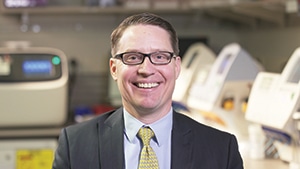Color has started by optimizing for a gene set based on a National Academy of Medicine paper (Murray MF, et al. “A Proposed Approach for Implementing Genomics-Based Screening Programs for Healthy Adults.” Dec. 3, 2018). The physician-ordered test covers hereditary breast and ovarian cancer syndrome (BRCA1, BRCA2), Lynch syndrome (MLH1, MSH2, MSH6, PMS2, EPCAM), and familial hypercholesterolemia (LDLR, APOB, PCSK9). All three conditions have high penetrance and effective interventions for prevention or reducing risk, yet most people at risk are unaware of their status.

“Labs need to step up and be involved in doing this from the get-go. They’re the experts. They’re the ones who should be directing elective genomics.” — David Bick, MD
The panel not only has the academy’s imprimatur, she says, but it’s the perfect size, at least for now. “People go too much, too far, too fast with genes,” she says. “It’s completely overwhelming to the primary care physician—really, to all physicians except geneticists. But starting with these three conditions makes it just a little bit easier of a starting base.” Consumer genomics needs to be a good experience for physicians as well as patients, she says.
“We also have to convince our buyers that our product is going to have beneficial health outcomes,” Dr. Hagenkord says. “So we can’t optimize it for junky ‘trinkets’ or fun stuff.” Once the health hurdle has been cleared, however, it makes sense to “use whatever other levers we can with genetics—because people find it so interesting—to create continued engagement around health actions you want them to take.”
“Genetics has been shown to be an activator,” she continues. “People have this health awareness moment when they get the genetics,” which, ideally, can be used to nudge them into the programs that would be most beneficial. Color also offers a collaborative health history and personal health history app, which Dr. Hagenkord characterizes as “a learning system that tracks its own effectiveness as we go along.” Participants can have the results sent to physician(s) of their choice; for health care clients, results are integrated into the EHR.
Says Dr. Hagenkord: “Patient-reported outcomes turns out to be pretty reliable for certain types of information.” She suggests that answering a survey while sitting on the couch—in the consumer genomics world, patients seem to enjoy filling out forms while sitting on their couches—is less stressful than sitting in a physician’s office “and being judged by the white coat.” The app allows family members to share family health history and build information “that’s much richer and more reliable than the health history you give in 60 seconds during your doctor’s visit,” she says. “You can actually ask your Uncle Mark in Green Bay, Wis., if he ever had a blood clot, or what kind of cancer he had, and how old was he? And then we can share that in a structured way with our health system partners.”

“I’m eager to see post-market surveys to see if consumers are enjoying this as much as we did in the lab as we built it.”
— Matthew Ferber, PhD
Several studies have demonstrated this engagement also translates to compliance, she says. One study showed that patients who were prescribed a statin and received genetic information were up to 43 percent more compliant with their drug, up to 18 months out, than a group that received no such information at the time of prescription. Yet traditional medicine has never considered using genetics to motivate patients, she says.
Dr. Hagenkord doesn’t mince words when she peers into the future. Labs “will have to get on board eventually.”Drawing on her years in Silicon Valley, Dr. Hagenkord says, “If you look at the way we do everything else in our lives right now, everything is app-based, convenient, frictionless. The only thing really left in our lives that is analog and not consumer-friendly, and very 20th century, is health care. Ten years from now, that’s going to be completely different,” she says. Case in point: 10 years ago, the roads were Uber-free and smartphones were a novelty. “You can see how that completely changed our expectations on how to live our daily lives. I think that’s going to happen in health care.”
In the relatively near future, Dr. Hagenkord predicts, sequencing will be within-rounding error-free and become a commodity. “So the value of genomic sequencing isn’t having the sequence itself; the value is in what you do with it.”
Different companies are placing different bets on what that value is. Color, obviously, is “making a population health play. Some of us are going to be more focused on health outcomes,” she says. “Some of us are going to be more focused on fun and delight. Some of us are going to be more focused on ancestry.” Trying to understand the field as it unfolds will be futile without understanding the underlying business models.
She worries, however, that the various models are making matters needlessly complicated. A test designed for research and ancestry, using older technologies, won’t detect pathogenic rare variants and novel variants. “It’s confusing the marketplace,” Dr. Hagenkord says, even with clear FDA labeling that indicates the limitations of such genetic testing. That in turn could sow doubt among physicians just when they need to become more involved.
Dr. Ferber says he himself was a skeptic early on. “I used to look at these consumer-focused genomics companies and quite honestly, I didn’t agree with the direction they were going. And some of them, I still don’t.” But done right, he says, everyone can benefit.
Even so, he says, “The vast majority of physicians aren’t comfortable talking about genetics.” So it wouldn’t surprise him, he says, if many of them dismissed consumer genomics tests out of hand. “I totally get it,” he says.
But the move toward digital and automation is inevitable, he says, echoing, Dr. Hagenkord. “So it’s going to be even more important, as this happens, to make sure that people know that consumer tests are for an otherwise well population,” Dr. Ferber says. “If somebody is sick, or suspects themselves of having a disease, that, to me, is off limits. That, to me, is a physician visit. We have to work hard to not confuse people. That’s not safe, and that’s not good for any of us.”
Companies that got an early start in consumer genetic testing have played their cards differently than clinical labs—a game of Go Fish versus contract bridge. By focusing on consumers, not the test per se, “They’ve always been a bit more Silicon Valley,” Dr. Ferber says, “a little bit more, Don’t confuse people with the details—just keep them engaged, keep them excited. But the details are important. How do you communicate—without losing them?” He’s confident clinical labs will find the answer. “It may seem like we’re behind, but this is a pretty long race to run. It’s not too late.”
Dr. Ferber also foresees a time when consumer genomics will become the norm. At a low enough price, he says, widespread genetic testing will be as valuable as newborn screening. “I see a time when everybody gets this. I don’t know what the appropriate age would be. But there comes a time when healthy people should just know this type of stuff.”Using his own experience as a guide, Dr. Ferber would like physicians at least to start thinking and talking about it. “My knee-jerk reaction was, This is bad. And it’s met with a lot of cautionary tales about the demands it will place on the health care system.” Done correctly, however, the right people will receive the right tests, he insists, and labs will be educating an important group of patients about genetics much faster than they ever could before.
Dr. Bick thinks he sees an easier road. Many labs are already running clinical tests that could transfer to the elective realm. “That’s an immediate way to get into offering elective testing without a huge financial commitment.” He agrees physicians might push back—but not all of them. “Not to be too mean to the oldsters,” he says (noting that he’s in his 60s), “but younger physicians are more likely to look at regular diagnostic genetic testing as part of regular care—and by the same token, elective genetic testing.”
Labs that do become involved can help head off the horror stories that emerge when people receive confusing results. “Having raw data doesn’t help you; it could, in fact, confuse you,” Dr. Bick says. A sophisticated laboratory can tell patients and physicians if the data are good, and what they mean. “Labs need to step up and be involved in doing this from the get-go. They’re the experts. They’re the ones who should be directing elective genomics. And they should be doing it tomorrow.”
Some of the pushback Dr. Hagenkord has seen from physician colleagues is tied to outdated information. “Most people aren’t up to date on how consumer genomics has evolved,” she says. When polygenic risk scores came on the scene as part of the first wave of DTC genomic testing, “no one was talking about consumers. And the entire complaint by the entire medical professional community was almost exclusively on the fact that there was no established clinical validity for the polygenic risk scores that these companies were providing.” That has changed, she says. Old technology was SNP-based, but virtually everyone has moved to clinical-quality sequencing and uses board-certified experts to interpret/report results, she says. Nevertheless, colleagues are still reciting the old mantra about lack of clinical validity.The debate needs to change, she says. “It’s not about, is this test accurate or not? It’s the same test that you would get at any clinical lab,” but cheaper and easier to get.
Since Color launched in 2015, Dr. Hagenkord has learned a few things about the consumer perspective. Chief among her findings: “People love to learn about themselves, and they love to talk about themselves.” Combining the two leads to a “virtuous cycle, an exchange of information that both parties seem to benefit from.”
Consumers want to know, among other things, their APOE-related Alzheimer’s risk, she says. Even though they can’t act on this information, “Consumers find it interesting and engaging. People are declaring what they find to have personal utility as opposed to this very strict clinical utility model that we have in the nonconsumer world.”
Need more proof? Dr. Hagenkord recounts 23andMe’s voluntary research efforts, which she says attracts a very high percentage of the test’s buyers. As part of those efforts, the company asks its users what topics they’re interested in. One example in particular makes Dr. Hagenkord laugh. “23andMe was able to, with a few clicks of a button, do the world’s largest genomewide association study on stretch marks.
“Trust me: The NIH is never going to fund a $5 million, five-year stretch marks project.”
Karen Titus is CAP TODAY contributing editor and co-managing editor.
 CAP TODAY Pathology/Laboratory Medicine/Laboratory Management
CAP TODAY Pathology/Laboratory Medicine/Laboratory Management
